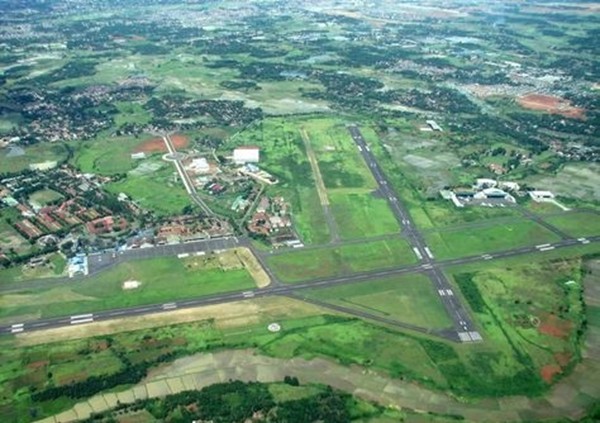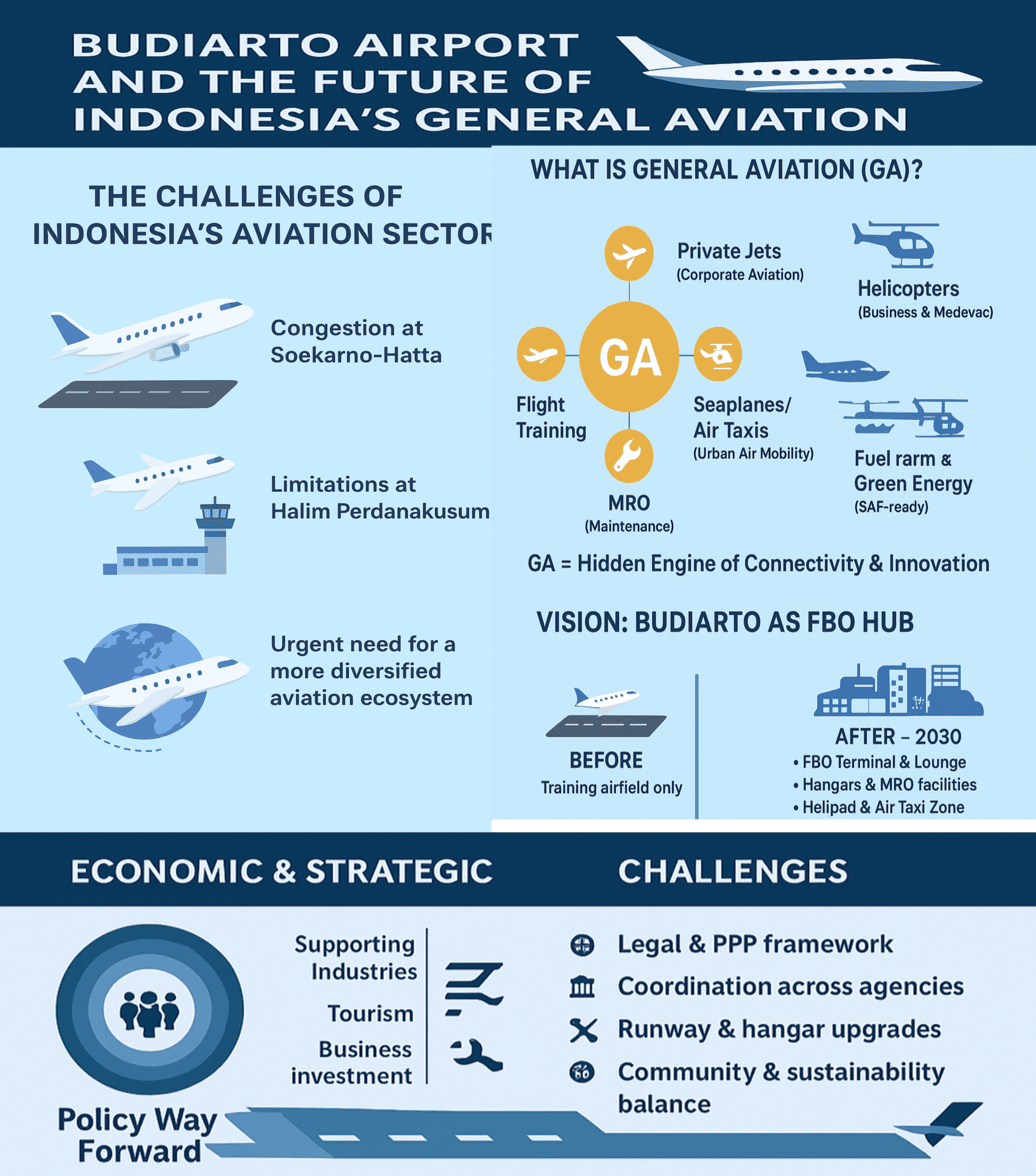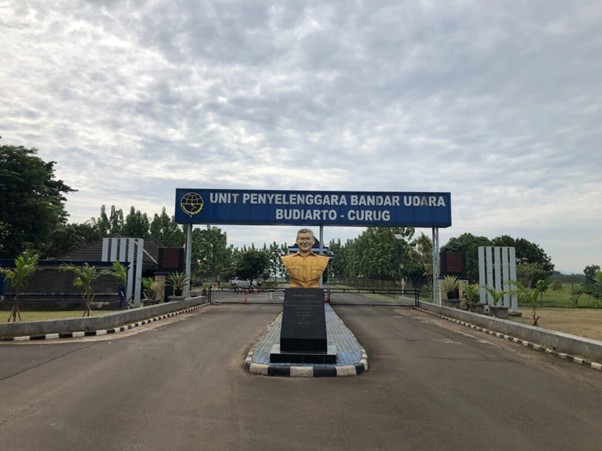On the outskirts of Jakarta, in Curug, Tangerang, sits an airfield that policymakers and industry leaders alike have long overlooked. Budiarto Airport, details of which can be accessed at https://hubud.kemenhub.go.id/hubud/website/bandara/102, is not glamorous. It does not host international flights, nor does it see the bustling crowds of Soekarno-Hatta International Airport. Instead, it has been primarily associated with the Indonesian Aviation Polytechnic (IAP Curug), a school for training pilots and aviation professionals.
But in an age when Indonesia’s aviation sector is under increasing pressure—struggling with congestion at Soekarno-Hatta, limitations at Halim Perdanakusuma, and an urgent need for a more diversified aviation ecosystem—Budiarto emerges as an unlikely but highly strategic candidate for transformation.
The vision? To turn this modest airfield into the nation’s Fixed Based Operation (FBO) hub for General Aviation (GA): a dedicated base for private jets, corporate aviation, helicopter services, air taxis, medevac flights, and maintenance facilities.
This idea is not just about building luxury lounges for the elite. It is about reshaping Indonesia’s aviation ecosystem, expanding opportunities for entrepreneurs, and anchoring the country’s aviation future on principles of sustainability, inclusiveness, and competitiveness.
Why General Aviation Matters
For too long, Indonesia’s aviation discourse has been monopolized by commercial airlines. When most Indonesians think of aviation, they think of Garuda, Lion Air, or AirAsia. Yet around the world, aviation is not just about scheduled flights between major cities. General Aviation—everything outside of scheduled commercial services—forms the backbone of dynamic economies.
In the United States, General Aviation contributes over USD 250 billion annually to GDP and supports more than a million jobs. In Europe, GA provides critical services ranging from air ambulances to agricultural surveys. Singapore’s Seletar Airport is home to thriving FBOs that cater to corporate jets and maintenance operations. Malaysia’s Subang Airport has transformed into a mixed-use aviation hub, supporting private charters and MRO (maintenance, repair, and overhaul) services. Even in small island states such as the Maldives, GA is central to connecting remote communities and supporting tourism.
GA is, in many ways, the “hidden engine” of aviation. It provides flexibility, connectivity, and resilience. It allows entrepreneurs to start charter services without the massive capital required for airlines. It enables corporations to access markets efficiently. It supports medevac and emergency services, often acting as the first responder in disasters. And it nurtures the skills pipeline for pilots, engineers, and air traffic managers.
For Indonesia, an archipelago of more than 17,000 islands, General Aviation is not a luxury—it is a necessity. The promise of regional connectivity cannot be fulfilled by commercial airlines alone. GA fills the gaps, connects the underserved, and provides the agility that a vast and complex geography demands.

Indonesia’s Aviation Bottlenecks
Yet Indonesia’s aviation infrastructure is structurally imbalanced. Soekarno-Hatta International Airport, the primary gateway, handles more than 60 million passengers annually and struggles with congestion on both the airside and landside. Slots are scarce, delays are frequent, and expansion options are increasingly costly.
Halim Perdanakusuma, once envisioned as Jakarta’s secondary airport, is hampered by its dual-use status with the Indonesian Air Force. Slots for civil aviation are strictly limited, and the airfield’s location within a dense urban environment restricts further expansion.
Beyond these two, options are limited. Other airports near Jakarta are either too far (Kertajati in West Java, which itself struggles with underutilization) or unsuitable for GA development. As a result, private operators, helicopter companies, and air ambulance providers are squeezed out of the system. They face high costs, limited facilities, and bureaucratic hurdles.
The absence of a dedicated GA hub has real consequences. It discourages investment in new aviation startups. It forces corporate aviation into congested airports, adding pressure on commercial operations. And it prevents Indonesia from developing a balanced, resilient aviation ecosystem.
Budiarto’s Untapped Potential
This is where Budiarto enters the picture. Located just outside Jakarta, in Curug, Tangerang, the airfield has several features that make it an ideal candidate for a GA hub.
First, its location is strategic. It is close enough to Jakarta’s central business district—reachable in under an hour under normal traffic conditions—yet far enough to avoid the congestion and security sensitivities of inner-city airports.
Second, Budiarto already has aviation infrastructure in place. The runway is sufficient for small and medium-sized jets, helicopters, and turboprops. The presence of the Indonesian Aviation Polytechnic provides a built-in ecosystem of aviation professionals, training facilities, and a pipeline of skilled graduates.
Third, the land around Budiarto is more flexible compared to Soekarno-Hatta or Halim. Expansion for hangars, lounges, MRO facilities, and fuel farms is feasible at a lower opportunity cost. This makes Budiarto a practical site for developing an integrated FBO and GA cluster.
Most importantly, transforming Budiarto would not require competing with Soekarno-Hatta’s commercial mandate. Instead, it would complement Jakarta’s aviation network by absorbing GA traffic, freeing up precious capacity at the main gateway, and creating a new pole of growth.
The Economic and Strategic Case
The potential economic impact of turning Budiarto into an FBO hub is significant.
First, the multiplier effect on jobs and services would be substantial. An FBO requires not just pilots and ground handlers, but also maintenance engineers, fuel suppliers, catering providers, and hospitality staff. Local communities around Curug would see new opportunities for employment and business.
Second, an FBO hub stimulates entrepreneurship. Startups offering air taxis, on-demand charters, drone logistics, or aerial surveys could base themselves at Budiarto without competing with commercial airlines for slots. Indonesia’s growing middle class and corporate sector are increasingly interested in flexible, point-to-point travel solutions, and a GA hub could provide exactly that.
Third, GA strengthens resilience. Medevac flights, disaster relief operations, and firefighting services could all be based at Budiarto, ensuring rapid deployment during emergencies. Given Indonesia’s vulnerability to natural disasters, this is not a secondary benefit but a core national interest.
Fourth, positioning Budiarto as a regional GA hub would enhance Indonesia’s standing in ASEAN aviation. While Singapore, Malaysia, and Thailand have invested in GA infrastructure, Indonesia remains underdeveloped in this sector. A strong GA hub would diversify Indonesia’s aviation profile and attract international operators.
Challenges to Address
Of course, such a transformation will not be without challenges.
Legal and administrative hurdles loom large. The land status of Budiarto must be clarified, concession models agreed upon, and regulatory frameworks for FBO operations established. Coordination between the Ministry of Transportation, the Directorate General of State Assets (DJKN), and local government will be essential.
Operational challenges also exist. The runway, taxiways, and aprons will need upgrading to meet international GA standards. Modern hangars, fuel storage, and ground support equipment must be developed. Integration with CNS/ATM (communication, navigation, and surveillance/air traffic management) systems is critical to ensure safety.
Financial considerations will require careful design. Developing an FBO hub is a capital-intensive endeavour. Public-private partnership (PPP) models, tax incentives, and targeted investment schemes may be necessary to attract investors.
Finally, social and environmental dimensions cannot be ignored. Local communities must see tangible benefits—jobs, business opportunities, infrastructure improvements—otherwise resistance will grow. At the same time, the hub must commit to sustainable practices, such as green building standards, noise mitigation, and renewable aviation fuels.
Policy Pathway
So how can policymakers move forward?
First, create an enabling regulatory framework. Clear guidelines for FBO licensing, transparent land concession agreements, and simplified approval processes will provide certainty for investors.
Second, introduce targeted incentives. Tax breaks for MRO investments, reduced import duties for GA equipment, and streamlined customs procedures for spare parts can make Budiarto attractive. Establishing the airport as a Special Aviation Economic Zone could further accelerate growth.
Third, strengthen governance through an Aviation Cluster Authority. Rather than leaving Budiarto to fragmented oversight, a dedicated authority could coordinate between ministries, investors, and local stakeholders.
Fourth, embed sustainability and inclusiveness at the heart of the project. Renewable fuel infrastructure, green hangar design, and community partnership programs should be non-negotiable pillars of development. This would align Budiarto with Indonesia’s broader climate commitments and SDGs.
Finally, integrate Budiarto into the national aviation roadmap. GA should no longer be treated as a peripheral activity but as a strategic component of Indonesia’s aviation future.

A Symbol of Aviation Democracy
Ultimately, the case for transforming Budiarto is not just technical or economic. It is symbolic.
For decades, aviation in Indonesia has been seen as the domain of big airlines and major airports. Ordinary entrepreneurs, small operators, and local communities have had little space in the system. By dedicating Budiarto to GA, Indonesia would signal a new era of aviation democracy: one where the benefits of aviation are more widely distributed, and innovation is not stifled by structural bottlenecks.
Budiarto’s transformation would show that aviation policy is not just about managing congestion at Soekarno-Hatta or negotiating international airline routes. It is about building a resilient, inclusive ecosystem that serves national interests, empowers local communities, and prepares the country for the next wave of aviation innovation.
Indonesia is at a crossroads. Its aviation sector faces mounting pressures but also unprecedented opportunities. The choice is clear: continue with a narrow, airline-centric model that leaves GA underdeveloped, or embrace a diversified ecosystem where Budiarto becomes the beating heart of General Aviation.
If policymakers are bold, Budiarto could move from being an overlooked training airfield to becoming Indonesia’s first true FBO hub—a gateway not just for jets and helicopters, but for a more democratic, sustainable, and competitive aviation future.

